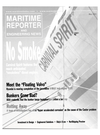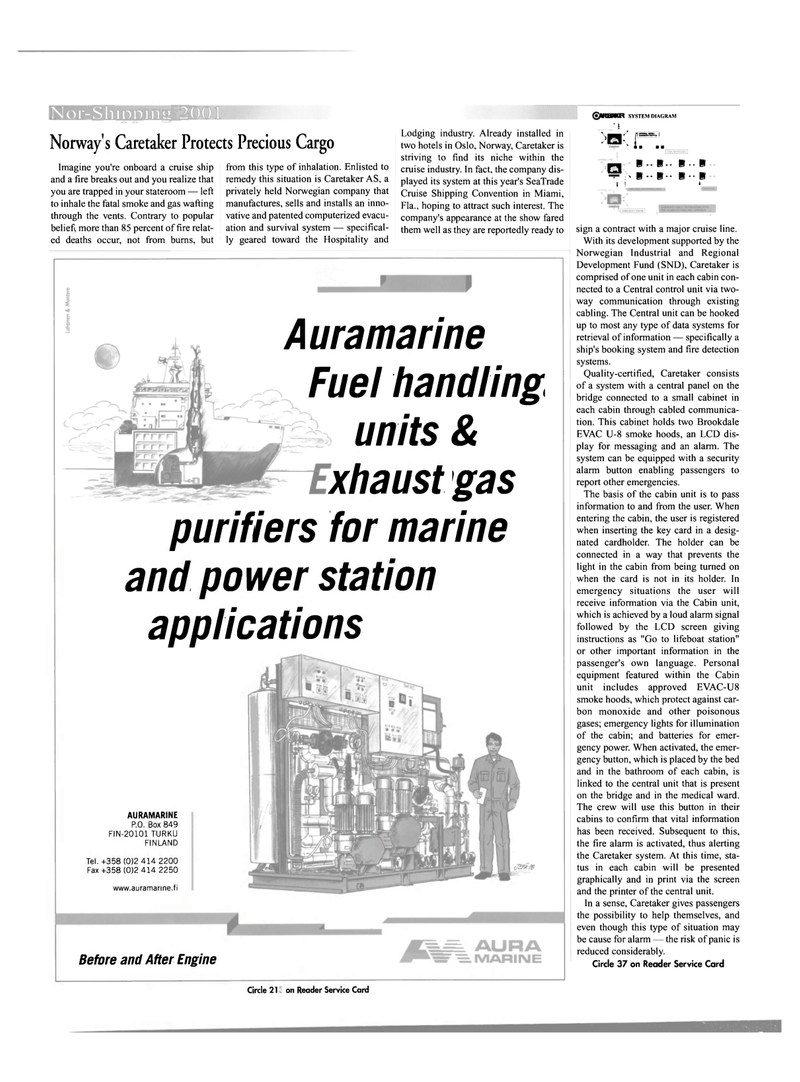
Page 50: of Maritime Reporter Magazine (May 2001)
Read this page in Pdf, Flash or Html5 edition of May 2001 Maritime Reporter Magazine
Nor-Shmninir 2(
Norway's Caretaker Protects Precious Cargo
Imagine you're onboard a cruise ship and a fire breaks out and you realize that you are trapped in your stateroom — left to inhale the fatal smoke and gas wafting through the vents. Contrary to popular belief, more than 85 percent of fire relat- ed deaths occur, not from burns, but from this type of inhalation. Enlisted to remedy this situation is Caretaker AS, a privately held Norwegian company that manufactures, sells and installs an inno- vative and patented computerized evacu- ation and survival system — specifical- ly geared toward the Hospitality and
Lodging industry. Already installed in two hotels in Oslo, Norway, Caretaker is striving to find its niche within the cruise industry. In fact, the company dis- played its system at this year's SeaTrade
Cruise Shipping Convention in Miami,
Fla., hoping to attract such interest. The company's appearance at the show fared them well as they are reportedly ready to
OtREMKR SYSTEM DIAGRAM " \ >•( P ' i • • b n B - B •• B =?r \ B - B-• B -- B ! I » sign a contract with a major cruise line.
With its development supported by the
Norwegian Industrial and Regional
Development Fund (SND), Caretaker is comprised of one unit in each cabin con- nected to a Central control unit via two- way communication through existing cabling. The Central unit can be hooked up to most any type of data systems for retrieval of information — specifically a ship's booking system and fire detection systems.
Quality-certified, Caretaker consists of a system with a central panel on the bridge connected to a small cabinet in each cabin through cabled communica- tion. This cabinet holds two Brookdale
EVAC U-8 smoke hoods, an LCD dis- play for messaging and an alarm. The system can be equipped with a security alarm button enabling passengers to report other emergencies.
The basis of the cabin unit is to pass information to and from the user. When entering the cabin, the user is registered when inserting the key card in a desig- nated cardholder. The holder can be connected in a way that prevents the light in the cabin from being turned on when the card is not in its holder. In emergency situations the user will receive information via the Cabin unit, which is achieved by a loud alarm signal followed by the LCD screen giving instructions as "Go to lifeboat station" or other important information in the passenger's own language. Personal equipment featured within the Cabin unit includes approved EVAC-U8 smoke hoods, which protect against car- bon monoxide and other poisonous gases; emergency lights for illumination of the cabin; and batteries for emer- gency power. When activated, the emer- gency button, which is placed by the bed and in the bathroom of each cabin, is linked to the central unit that is present on the bridge and in the medical ward.
The crew will use this button in their cabins to confirm that vital information has been received. Subsequent to this, the fire alarm is activated, thus alerting the Caretaker system. At this time, sta- tus in each cabin will be presented graphically and in print via the screen and the printer of the central unit.
In a sense, Caretaker gives passengers the possibility to help themselves, and even though this type of situation may be cause for alarm — the risk of panic is reduced considerably.
Circle 37 on Reader Service Card
Aura marine
Fuel handling units & xhaust gas purifiers for marine and power station applications
AURAMARINE
P.O. Box 849
FIN-20101 TURKU
FINLAND
Tel. +358 (0)2 414 2200
Fax +358 (0)2 414 2250 www.auramarine.fi
Before and After Engine
Circle 231 on Reader Service Card

 49
49

 51
51
